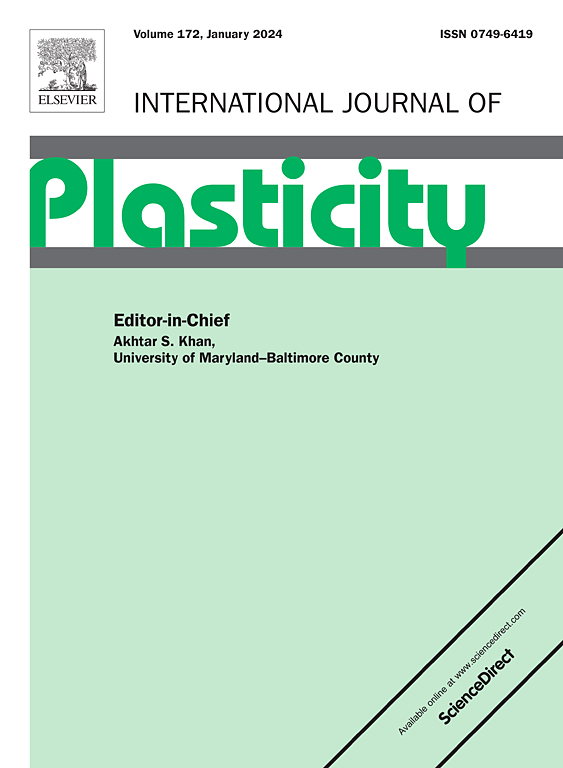Deformation behavior and strengthening mechanisms of high-entropy alloys under high strain rate across wide temperature ranges
IF 12.8
1区 材料科学
Q1 ENGINEERING, MECHANICAL
引用次数: 0
Abstract
This study systematically investigates the deformation mechanism and strengthening effects of the CoCrFeNiMn0.75Cu0.25 high-entropy alloy (HEA) under dynamic tensile loading across a wide temperature range (93 K to 1073 K). The HEA exhibits a ∼30 % enhancement in strength and ductility at 93 K relative to its performance at 298 K. These superior properties result from the synergistic interactions among deformation bands, stacking faults, multiscale twinning, dislocations, and Lomer-Cottrell (L-C) locks, which enhance work hardening and delay fracture. At 873 K, dislocation slip becomes dominant, and dynamic recovery is activated, facilitating stress redistribution and more uniform macroscopic deformation. At 1073 K, discontinuous dynamic recrystallization occurs within deformation bands, producing refined grains that redistribute stress and maintain elongation above 60 %, ensuring superior plasticity despite thermal softening. These findings indicate that temperature strongly influences microstructural evolution, with thermally activated dislocation motion, recovery, and recrystallization playing critical roles in determining the deformation response at high strain rates. This study provides new insights into the temperature-dependent strengthening mechanisms in HEAs, which have implications for the development of advanced materials for extreme environments.
高熵合金在高应变速率下宽温度范围的变形行为及强化机制
本研究系统地研究了CoCrFeNiMn0.75Cu0.25高熵合金(HEA)在宽温度范围(93 K至1073 K)动态拉伸载荷下的变形机制和强化效果。HEA在93 K时的强度和塑性比298 K时的性能提高了约30%。这些优异的性能是变形带、层错(SFs)、多尺度孪晶、位错和lomo - cottrell (L-C)锁之间的协同作用的结果,这些作用增强了加工硬化和延迟断裂。在873 K时,位错滑移起主导作用,激活动态恢复,有利于应力重分布和更均匀的宏观变形。在1073 K时,变形带内发生不连续动态再结晶(DDRX),产生细化的晶粒,重新分配应力并保持60%以上的伸长率,确保了热软化后的优异塑性。这些发现表明,温度强烈影响微观组织的演变,热激活的位错运动、恢复和再结晶在决定高应变速率下的变形响应中起着关键作用。该研究为HEAs中温度依赖的强化机制提供了新的见解,这对极端环境下先进材料的开发具有重要意义。
本文章由计算机程序翻译,如有差异,请以英文原文为准。
求助全文
约1分钟内获得全文
求助全文
来源期刊

International Journal of Plasticity
工程技术-材料科学:综合
CiteScore
15.30
自引率
26.50%
发文量
256
审稿时长
46 days
期刊介绍:
International Journal of Plasticity aims to present original research encompassing all facets of plastic deformation, damage, and fracture behavior in both isotropic and anisotropic solids. This includes exploring the thermodynamics of plasticity and fracture, continuum theory, and macroscopic as well as microscopic phenomena.
Topics of interest span the plastic behavior of single crystals and polycrystalline metals, ceramics, rocks, soils, composites, nanocrystalline and microelectronics materials, shape memory alloys, ferroelectric ceramics, thin films, and polymers. Additionally, the journal covers plasticity aspects of failure and fracture mechanics. Contributions involving significant experimental, numerical, or theoretical advancements that enhance the understanding of the plastic behavior of solids are particularly valued. Papers addressing the modeling of finite nonlinear elastic deformation, bearing similarities to the modeling of plastic deformation, are also welcomed.
 求助内容:
求助内容: 应助结果提醒方式:
应助结果提醒方式:


